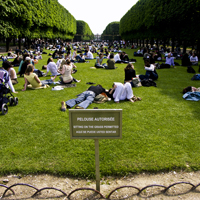
Prati, commons
International Landscape Study Days
2017, thirteenth seminar
Treviso, Thursday and Friday, 16 and 17 February
This year, the discussion of the thirteenth edition of the International landscape study days, devised by the Foundation for 16 and 17 February 2017, is organised around the word “common” seen as a place, and around the various declinations – prato, pré, prado, green, common, … – that this place holds in the history of the city.
In the wake of an experience conducted in the field, the Foundation’s 2016 workshop on the theme of “Prato della Fiera. Treviso, il Sile e il paesaggio di un grande spazio pubblico (Prato della Fiera. Treviso, the Sile and the landscape of a large public space)” which represented an instance of investigation of a vast, empty, urban space infixed in the city’s history, the discussion on the value of “commons” and the search for new meanings of common areas in the contemporary urban context continues.
What initially appears to be the domain of a colour (green?), a measurable space in terms of environment, function, town planning, or a “discovery” for someone looking at the history of the urban landscape in its less ostentatious aspects may be, on the other hand, an inconvenient yet promising terrain, teeming with interrogatives to discuss the value of public spaces, of their current meaning in relation to culture and the practice of landscape.
Spread out in the fringes of old and new suburbs, the commons – the “new commons”, as they will be referred to during the study days – are now spaces waiting for us to contemplate the value of sociality, the sense of common wealth, the need to inhabit a connective fabric that requires a summarising approach, beyond the visions of the various disciplines.
Historically, commons were fair and market grounds, places of intense licit and illicit exchange, until a different urban and social order changed the borders, changed their perception to the point of recognising potential in their abandon.
The nature of these places, characterised by vast dimensions, the lack of any structured plan, more or less-deliberate multi-functionality, requires a landscape perspective, able to grasp the sense of their entirety. In this sense the large clearing of Amsterdam’s museum district – Museumplein, designed by landscape architect Sven-Ingvar Andersson – sets the bar high, as it did in 2008, when the location was awarded the Carlo Scarpa Garden Prize. This example bridges the history of the out-of-town “commons” and the long season, still underway, of the many clearings and spaces that have been handed over to the contemporary city through the abandonment of industrial activities and infrastructures. In these places we set our bets on a new landscape that leans towards, for example, the “return” of spontaneous plant communities as a design plan, such as the spread of many “grass roots initiatives” that other communities, the city-communities, use to set up new forms of use, of sociality, of landscape practices.
